
Posted on 09/07/2010 5:09:13 AM PDT by Homer_J_Simpson



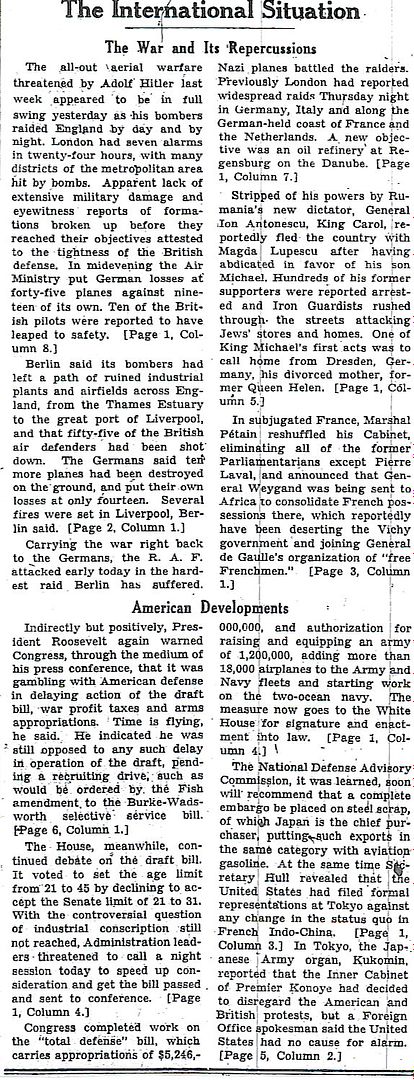
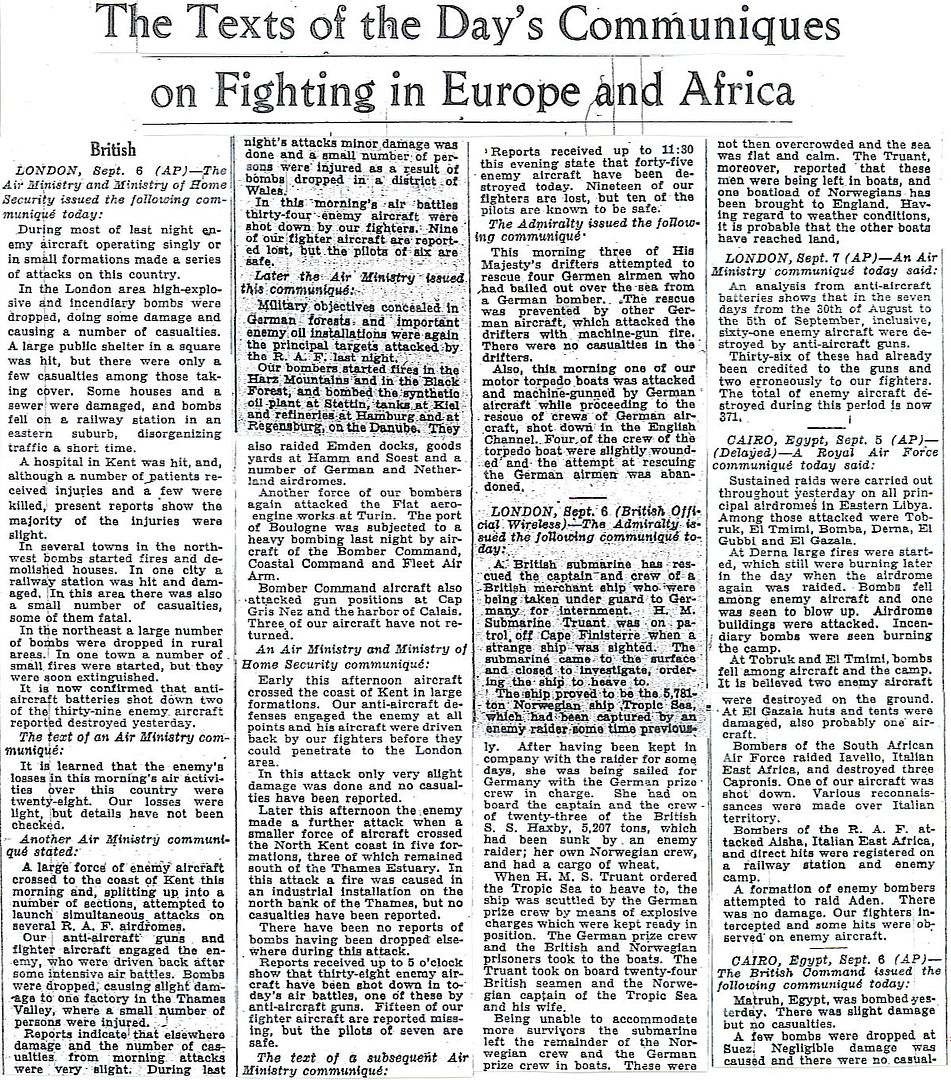
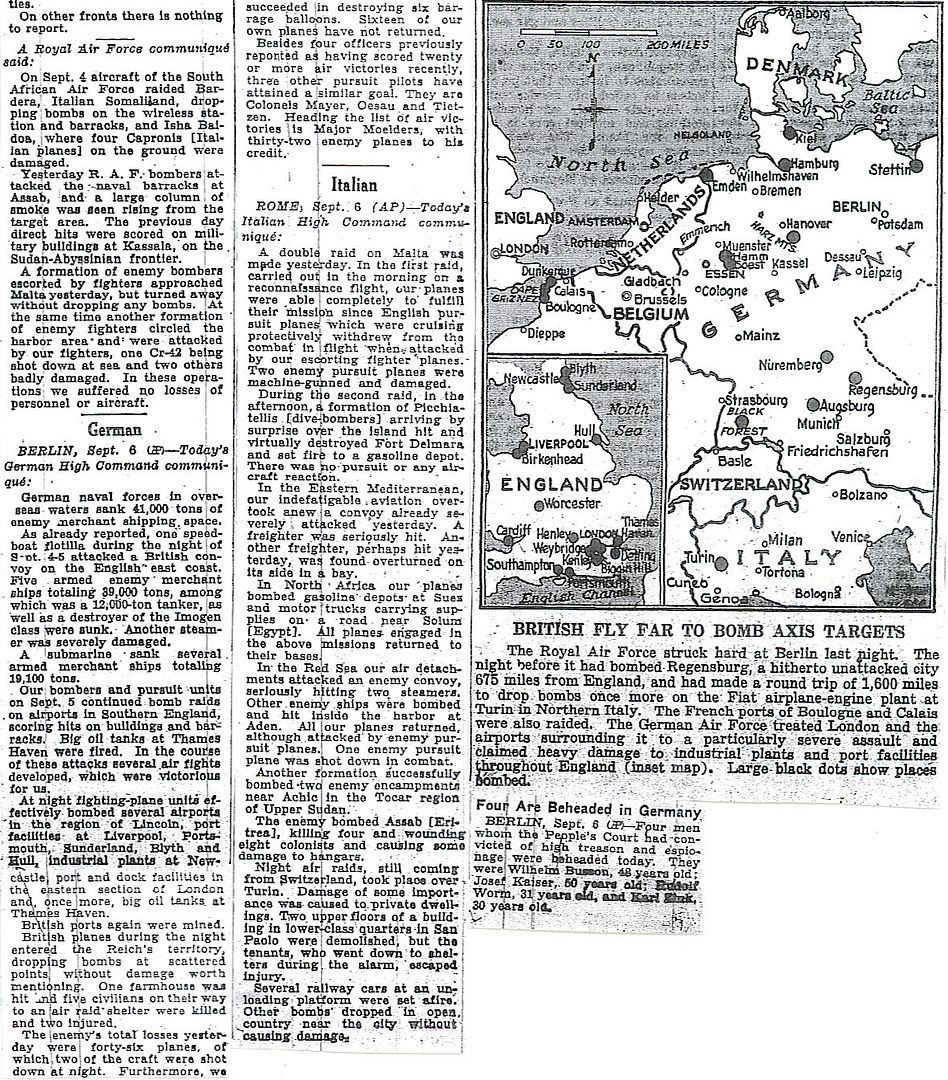
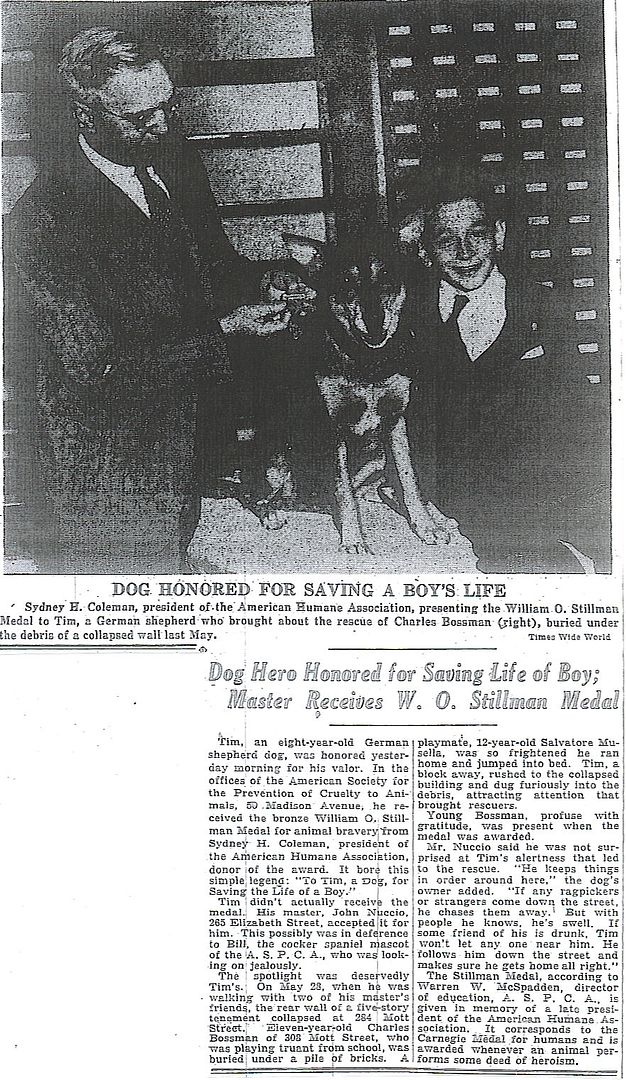
Plus a special guest map from Michael Korda’s, “With Wings Like Eagles,” showing the air defenses of England and Wales, August 1940.
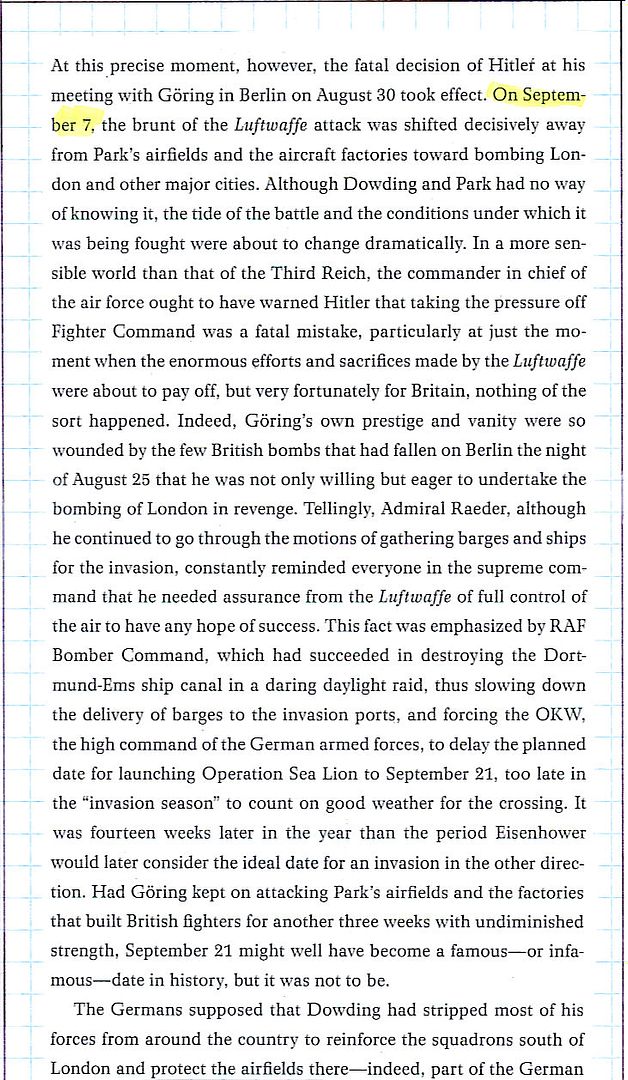
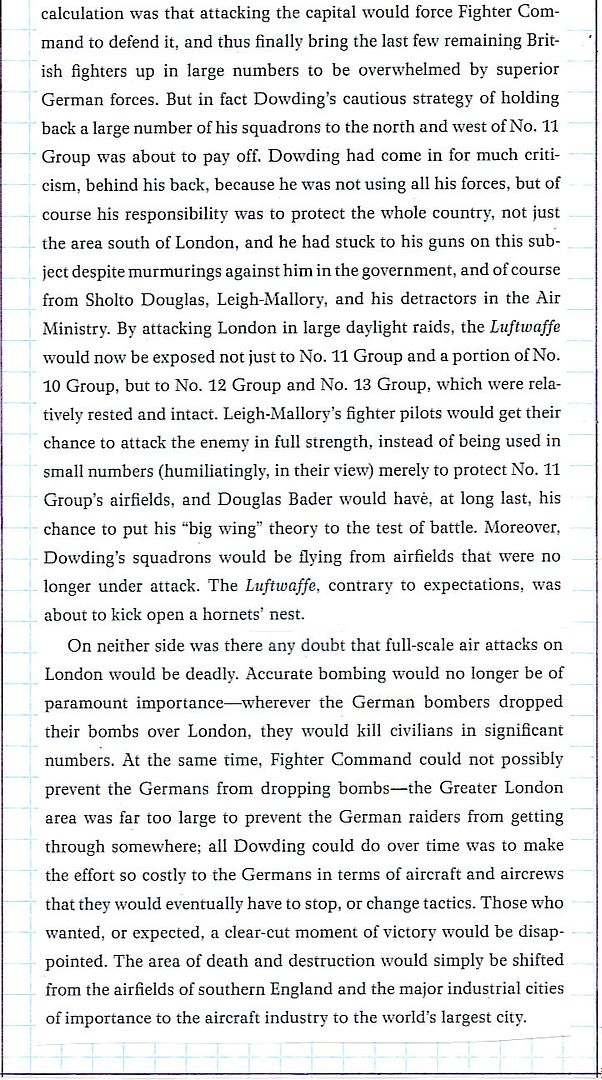
You can read Reston’s whole piece in the News of the Week in Review section tomorrow.
Michael Korda, With Wings Like Eagles: The Untold Story of the Battle of Britain
* German Shepherd story alert. Read the original account from May 29.
Now that's what I call a dog-hero.
http://www.onwar.com/chrono/1940/sep40/f07sep40.htm
Germans begin “The Blitz”
Saturday, September 7, 1940 www.onwar.com
Over Britain... The Germans alter the tactics of their air offensive and send a major daytime raid against London. This gives the RAF a welcome respite from the airfield attacks which have been so damaging during the last few days. The German attack on London follows from a suggestion of Hitler which coincides with Goring’s own theories. The German tactic is that the RAF will be forced to commit its carefully hoarded reserves and that they can then be destroyed. Kesselring’s 2nd Air Fleet is to attack London by day with 500 bombers (including some brought from Norway and Denmark) and 600 fighters. Sperrle is to attack by night with about 300 bombers, as all his fighters have been switched to Kesselring. In addition there are about 100 Me110s and over 200 Stukas. The British have about 350 aircraft in their frontline squadrons with more in reserve. Park is modifying his tactics slightly to cope with the bigger German formations and now intends pairing his squadrons where possible. In the afternoon the Germans send 300 bombers and 600 fighters to attack targets in the London dock area. The British interceptions are not well managed because of the change of tactics comes as a surprise. The Luftwaffe loses 41 aircraft and Fighter Command 28 shot down and several more damaged. The bombing is most effective. During the night Sperrle follows up the attack with 250 bombers with the still-blazing fires to guide them to their target. The damage is very serious. There is little the RAF can do at night to achieve interceptions although the first airborne radar sets are coming into operation. Despite the damage done it is clear that the casualties and the disruption of civilian life are not as great as prewar fears suggested. There is no question of the Germans achieving a decisive result in these operations. These attacks become known as “The Blitz” by the British people.
From London... The British authorities decide that they have information that a German invasion is likely in the next few days and accordingly they issue an invasion warning. This warning is in the form of the signal word “Cromwell” which means that an invasion is imminent and its issue causes some wild measures to be taken. In fact this signal has been chosen because its true meaning corresponds most nearly to the needs of bringing about a higher state of readiness. No other code word has this effect.
In the North Atlantic... During the night (September 7-8), U-47 sinks one ship from convoy SC-2 by attacking while surfaced.
http://homepage.ntlworld.com/andrew.etherington/month/thismonth/07.htm
September 7th, 1940
UNITED KINGDOM:
Battle of Britain:
RAF Fighter Command:
Losses: Luftwaffe, 41; RAF, 28.
RAF Bomber Command: 4 Group (Whitley). 51 Sqn. One aircraft crashed near Wells, Norfolk on return from Boulogne. Crew unhurt, aircraft wrecked.
Bombing - invasion fleet at Ostend and Boulogne.
51 Sqn. Four aircraft. Three got off but none bombed due to adverse weather.
One crashed on return, crew safe.
78 Sqn. Three aircraft. None bombed due to weather.
London: Today as many as 350 German bombers protected by as many fighters appeared over London’s docks. They were followed by another 247 tonight. A few hours later, with 2,000 Londoners dead or injured and the whole area engulfed by flames, all railway links south were blocked, and the decision was taken at GHQ Home Forces to send out the code word “Cromwell”: invasion imminent. Home Guard and regular troops were called out, church bells rung and some bridges blown.
Churchill had been warning the chiefs of staff that if an invasion is to be tried it cannot be long delayed, because the weather may break at any time. For the past few weeks hundreds of self-propelled barges have been observed moving down from German and Dutch harbours to ports of northern France. They have come under heavy bombardment from the RAF and the Royal Navy. But the massive bombing attack on London docks, which British forces interpreted as a prelude to an attempted German landing, does not appear to have been followed up by any movement of the invasion fleet. One theory is that the Germans hope that their air raids on civilian targets will cause such panic and chaos that invasion will be unnecessary.
RAF Fighter Command has a total of 59.5 fighter squadrons available: 31 Hurricane squadrons, 20 Spitfire squadrons, 6 Blenheim squadrons, 2 Defiant squadrons and 1/2 of a Gladiator squadron. (Jack McKillop)
London: London’s dockland is on fire tonight after a massive daylight raid in which more than 300 tons of high explosive and incendiary bombs rained on the capital, with the RAF seemingly unable to stop the death and destruction which fell from a stately procession of bombers onto the streets of East London.
Göring directed the attack from a clifftop in France, whence he watched 350 bombers escorted by 650 fighters stream across the Channel. Broadcasting from his HQ, he said he could see waves of planes heading for England.
It seems that the RAF have been wrong-footed this time, despite Enigma warnings of an at
tack on London. There have been raids on Hawkinge airfield this morning and thinking that the new wave of raiders were heading for airfields north of London, the 11 Group controller kept his squadrons north of the capital not realising that London was the target until it was too late. Eventually 21 out of 23 squadrons airborne managed to get into action and shot down 41 German planes for the loss of 25, but by then the damage had been done.
The first bombs set fire to bonded warehouses. Blazing rum, paint and sugar floated on the Thames. Many people had to be evacuated by boat. “Send all the pumps you’ve got,” pleaded one fire officer, “the whole bloody world’s on fire.” One of the problems facing the fire-fighters was that the level of the Thames had fallen in the dry summer and they had difficulty in getting their pumps to work. Later the sirens sounded again, and in the night 247 German aircraft attacked the capital, dropping 352 tons of high explosive and 440 canisters of incendiary bombs.
London: Mr Albert Ernest Dolphin (b. 1896), a porter, died when he flung himself under a falling wall, saving the life of a nurse trapped after a bomb hit the South-Eastern Hospital, New Cross. (George Cross)
The U.S. freighter SS Lehigh, detained by British authorities since 5 September, is released. The British then detain another U.S. freighter, SS Warrior. (Jack McKillop)
LUXEMBOURG: Anti-Semitic Nuremburg laws are applied to Jews living in Luxembourg by decree. (Jack McKillop)
GERMANY: Berlin: The German armed forces have drawn up detailed plans not only for invading the British Isles but for consolidating their positions after the initial landings. Operation Sealion entails the landing of a first wave of 13 divisions at a number of points on the south coast, from Ramsgate in the east to Lyme Regis in the west. Airborne troops will also be used. The Germans would then move inland to establish themselves on a line eastward from Gloucester to south of Colchester. By then they believe that Britain will have surrendered and a military government will be set up. But the difficulty of mounting an invasion without air superiority worries the chiefs of staff.
The prototype Blohm and Voss Bv 222 V1 six engined flying boat makes its maiden flight.
ITALY: Rome: The Italian High Command announced:
‘Italian bombers have again bombed oil refineries in the centre of Haifa and caused extensive fires. In North Africa our planes bombed the rail line between Alexandria and Marsa Matruh.’
EAST AFRICA: A Gloucester Gauntlet of No. 430 Flight (RAF) (K 5355) downs an Italian Caproni Ca 133.
CANADA: Corvette HMCS Dawson laid down Victoria, British Columbia. (Dave Shirlaw)
U.S.A.: The USN’s Cruiser Division 7 (Rear Admiral Andrew C. Pickens) sails to establish patrol off the eastern seaboard between Newport, Rhode Island, and Norfolk, Virginia. Heavy cruisers USS Quincy (CA-39) and USS Vincennes (CA-44) depart first, USS San Francisco (CA-38) (flagship) and USS Tuscaloosa (CA-37) follow. The ships, burning running lights, are to observe and report the movements of foreign men-of-war, and, as required, render prompt assistance to ships or planes encountered. (Jack McKillop)
Artie Shaw and his Orchestra recorded “Temptation” on the Victor label. (Jack McKillop)
Destroyer USS Hilary P Hones commissioned. (Dave Shirlaw)
ATLANTIC OCEAN: Off the coast of Spain, the British steamer SS Olivegrove is stopped, torpedoed and sunk by German submarine U-33 200 miles (322 km) northwest of Spain; upon receiving SS Olivegrove’s distress signal, U.S. passenger liner SS Washington, en route to the British Isles to evacuate American citizens from the European war zone, alters course and increases speed to reach the scene. Meanwhile, U-33’s commanding officer, Kapitanleutnant Hans-Wilhelm von Dresky, treats the British survivors courteously, and aids in their rescue by having distress rockets fired to guide SS Washington to the two lifeboats containing the 33-man crew, which she picks up without loss. (Jack McKillop)
The German submarine U-47 torpedoes and sinks three merchant vessels, two British and one Norwegian totalling over 14,500 tons, sailing in convoy SC-2 between Iceland and Ireland in position 58.30N, 16.10W. They are the SS Gro, SS José de Larringa and SS Neptunian. (Jack McKillop)
CARIBBEAN SEA: U.S. passenger liner SS Santa Paula is hailed by an unidentified RN cruiser 30 miles (48 km) off Curaçao, Netherlands West Indies, and ordered to stop; after a delay of 20 minutes, SS Santa Paula is allowed to proceed.
U.S. tanker SS I.C. White is challenged by unidentified cruiser 15 miles (24 km) off Baranquilla, Colombia, but is allowed to proceed without further hindrance. (Jack McKillop)
http://worldwar2daybyday.blogspot.com/
Day 373 September 7, 1940
Battle of Britain Day 60. On the brink of victory, Göring changes tactics. With RAF on its knees, Luftwaffe ceases bombing airfields, radar and aircraft works. Hitler, furious at the bombing of Berlin, believes Britain brought to the negotiating table by breaking the will of British civilians by terror bombing London. At 4 PM, a huge armada heads up the Thames Estuary (300 Heinkel and Dornier bombers & 200 Bf110s carrying bombs, escorted by 600 Bf109s). Soon, RAF has 23 squadron airborne waiting for them to split up. Instead they fly straight ahead to bomb London’s East End, including docks, shipyards & Woolwich Arsenal (igniting gunpowder stores for artillery shells). RAF tears into the retreating bombers, now unescorted by Bf109s which have returned home low on fuel. Luftwaffe loses 53 bombers and 21 Bf109s in all. RAF loses 27 fighters (15 pilots killed). Still burning, London’s East End is bombed continuously overnight (490 civilians killed, 1200 injured). http://www.battleofbritain1940.net/0036.html
Between 4 and 5.33 AM, 300 miles Northwest of Ireland, Günther Prien in U-47 sinks 3 steamers in convoy SC-2 en route to Britain from Sydney, Australia; British SS Neptunian carrying 8500 tons of sugar from Chile (all 36 hands lost), British SS José de Larrinaga carrying 5303 tons of steel and linseed oil from USA (all 40 hands lost) and Norwegian SS Gro carrying 6321 tons of wheat from Canada (11 killed, 21 survivors escape in 1 lifeboat and are picked up by British steamer Burdwan on September10, then transferred to corvette HMS Arabis and landed at Liverpool on 13 September).
Superb stuff as usual Homer. Thanks for posting.
Date: 7th September 1940

Start of Phase 3 of the Battle of Britain
________________________________________
Enemy action by day
Enemy activity did not develop until mid-morning when some thirty aircraft crossed the coast near Lympne but did not penetrate far inland. Dover and Hawkinge were attacked.
The main attack of the day started at 1635 hours and came over in two waves totalling some 350 aircraft which spread over Kent, making for the Thames Estuary, East London and aerodromes North and South of London. By 1814 hours all raids were homing. While the above raids were in progress some 24 aircraft approached the South Coast near Spithead but turned back. Reconnaissance flights were made over Liverpool and Manchester areas, Bristol Channel, Norfolk and Yorkshire.
During engagements with the enemy, our fighters destroyed 74 enemy aircraft (plus 34 probable and 33 Damaged). Our casualties amounted to 27 aircraft of which 14 pilots killed or missing.
East
In the early morning, one aircraft, picked up among returning bombers, flew across the Wash to Lincoln and out at Skegness, no interception effected. At 0920 hours, one Do215, plotted inland in Norfolk, was intercepted and shot down off the Dutch Coast. Two reconnaissance raids over convoys. One raid of some 6 aircraft 25 miles East of Lowestoft; fighters failed to intercept. A raid of one aircraft patrolled Yorkshire and was intercepted on its way out but escaped into cloud.
A further raid crossed the coast at Southwold and penetrated to Duxford.
South East
A number of early reconnaissance flights off the South East Coast and one overland between Harwich/Biggin Hill and Maidstone were made in the early morning.
First Attack: 1100-1200. After massing on the French Coast, some 70 enemy aircraft crossed the coast near Folkestone. A split from this raid flew along the coast to Hastings, the remainder spreading over East Kent. Dive bombing attacks were carried out against Hawkinge and Dover.
From 1300-1500 hours constant patrols averaging 6 aircraft in Calais/Boulogne district. At 1515 hours 10 aircraft patrolled the Straits and appeared to cross the coast near Lympne.
Second Attack: 1625-1814. First wave totalling some 100 aircraft crossed the coast but activities were confined to Kent. A second wave commenced to cross the Coast at 1718 hours, some 250 aircraft being plotted in five raids, the activity spread to an area from East of Kenley covering the Thames Estuary to as far North as Duxford. No 12 Group provided 5 Squadrons to assist No 11 Group during this engagement. A strong enemy patrol was maintained in the Straits down to Dungeness for about an hour after the attack.
South
At 0915 hours a raid of 3+ flew from Le Havre to Portsmouth. It was intercepted off the Isle of Wight and one Me110 shot down. A further raid of 2+ aircraft in this area was intercepted but decisive action by our fighters was prevented owing to our AA fire. During the period of the second attack in the South East, a raid of 12 aircraft approached Portsmouth but turned back before reaching the coast.
By night
Enemy activity commenced at 2010 hours when raids came out of Fecamp/Caen area, crossing the Coast near Shoreham. One raid went to Northolt and others to Kenley and Biggin Hill area. There was then a steady stream of raids mostly crossing between Beachy Head and Dungeness, spreading over Sussex/Kent/Essex and penetrating into Greater London area including Northolt where between five and eight raids were continuously plotted up to 0300 hours. By about 0430 hours the last raids had left Greater London area and were homing. Very slight activity over the remainder of the country. Isolated raids reached Liverpool/Birmingham and South Wales, and there was suspected minelaying activity off the Norfolk Coast before midnight.
By 0500 hours the whole country was clear of enemy raids.

________________________________________
Statistics
Fighter Command Serviceable Aircraft as at 0900 hours, 7th September 1940
Casualties:
| Enemy Losses | ||
| By Fighters | ||
| Destroyed | Probable | Damaged |
| 21 Me109 | 13 Me109 | 6 Me109 |
| 22 Me110 | 5 Me110 | 6 Me110 |
| 1 Me110(Jaguar) | ||
| 2 He113 | 1 He113 | |
| 4 Do17 | 4 Do17 | 5 Do17 |
| 18 Do215 | 3 Do215 | 10 Do215 |
| 5 Ju88 | 2 Ju88 | |
| 6 He111 | 3 He111 | 3 He111 |
| 1 French Aircraft (2 engined) | ||
| 74 | 34 | 33 |
| By Anti-Aircraft | Reported Sep. 8 | |
| 21 Enemy aircraft | ||
|
|
Patrols:
Balloons:
Aerodromes:
Organisation:
Home Security Reports
GOOD BOY!!
The snippet which shows the result of one nightly Luftwaffe bombing raid is less that two minutes long.
It shows a couple of the totally devasted blown-out multi-story buildings and stores on pricey Oxford street which was and still is the premier London shopping thoroughfare.
Included is a shot of the badly damaged flagship John Lewis department store, a well-known emporium of the day.....and which remains so today.
The snip shows rescue crews bringing out an injured man and what looks like victims on stretchers, dead or alive.
The text mentions that the clip shows Winston Churchill visiting the bomb sites, but I didn't see it....it must have been lopped off.
Too many folks today, especially the younger ones, have no clue of the horrors and shattered nerves endured by Londoners on a nightly basis. It behooves everyone to take a look at the up-close-and-personal destruction in this brief footage and to remember with the utmost admiration how the Brits 'carried on' with determination and courage.
Leni
Very cool. Be sure to stop by tomorrow, I’ll be posting an audio interview with a man who survived a bombing. Only about 2.5 minutes, but still pretty interesting.
My cousin and his wife are British, living in London. He's a retired opera singer from Covent Garden. We correspond by email. I never thought to ask him if he and his parental family went through the blitz. He may have been too young. I'll bring it up in my next email and see if has any observations on the subject.
BTW, my cousins are ardent conservatives (Tories) and they can't stand Obama. They are surprisingly 'up' on him and his evilness .....as are many Londoners.
Rule Britannia!
Leni
Let me know what he says. I’d be interested to hear it. My wife used to live in Ireland and we have many close friends there. Though they are all too young to have lived at the time, you will see me occasionally key in on aspects of the Irish experience in the fight to remain neutral and some of the ridiculous attempts by the Nazis to use that to their advantage.
“Film of the London Blitz in colour unseen for 70 years”
http://www.youtube.com/watch?v=rJUNHg11dRc
Wow. That is some amazing footage. And the whole 20 minutes will be put on the net tomorrow. We will have to post a link to that here.
More on Niemoeller:
"Friedrich Gustav Emil Martin Niemöller (14 January 1892 – 6 March 1984) was a German anti-Nazi theologian[1] and Lutheran pastor. He is best known as the author of the poem First they came...."
"Like most Protestant pastors, Niemöller openly supported the right-wing opponents of the Weimar Republic.
He even welcomed Hitler's accession to power in 1933, believing it would bring a national revival.
However, he decidedly opposed the Nazis' Aryan Paragraph.
In 1936, he signed the petition of a group of Protestant churchmen that sharply criticized Nazi policies and declared the Aryan Paragraph incompatible with the Christian virtue of charity.The Nazi regime reacted with mass arrests and charges against almost 800 pastors and ecclesiastical lawyers.
In 1933, Niemöller founded the Pfarrernotbund, an organization of pastors to "combat rising discrimination against Christians of Jewish background."[10]
By the autumn of 1934, Niemöller joined other Lutheran and Protestant churchmen such as Karl Barth and Dietrich Bonhoeffer in founding the Confessing Church, a Protestant group that opposed the Nazification of the German Protestant churches.
The author and Nobel Prize laureate Thomas Mann published Niemöller's sermons in the United States and praised his bravery."
There is much more of interest about Martin Niemoeller, including his WWI U-boat service.
He is perhaps representative of clergy who first supported the Nazis, but were later arrested and spent the war in concentration camps, where many perished.
Disclaimer: Opinions posted on Free Republic are those of the individual posters and do not necessarily represent the opinion of Free Republic or its management. All materials posted herein are protected by copyright law and the exemption for fair use of copyrighted works.